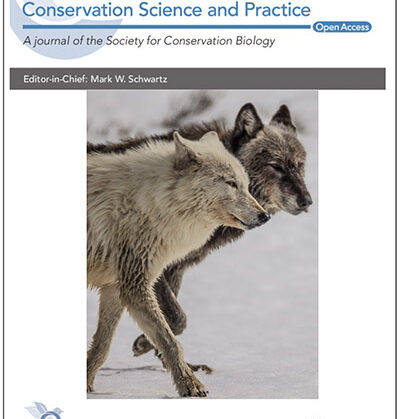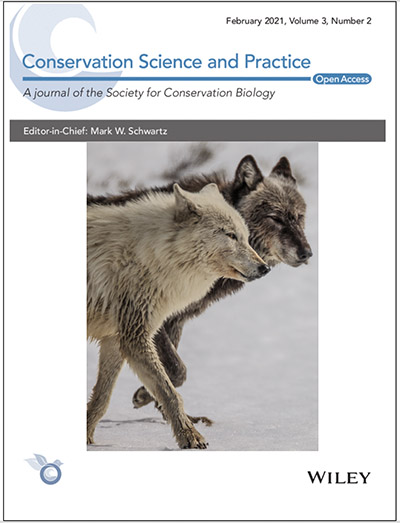
ORIGINAL PRESS RELEASE issued by Revive and restore, Heather Sparks; HEATHER@REVIVERESTORE.ORG
Article list follows
A newly published special issue of Conservation Science and Practice makes the case for rebalancing the risk–benefit equation in conservation.

About the cover: Together for 9 years, these wolves have the longest pair bond known for their species. They are descendants of a Yellowstone National Park wolf reintroduction program that initially drew controversy but is now widely considered a success. The reintroduction is detailed by Doug Smith and Rolf Peterson. (Courtesy Ronan Donovan)
Addressing the biodiversity crisis is at the heart of a new conservation initiative announced in today’s Conservation Science and Practice “Intended Consequences” special issue. This collection of articles written by experts in the fields of conservation biology, biotechnology, social science, and environmental ethics offers a framework for confidently tackling the world’s most urgent conservation problems.
“A singularly cautionary response to new technologies is no longer appropriate in the face of today’s biodiversity crisis. In many cases inaction will lead to more serious harm than action,” says Ryan Phelan, an editor of the new issue and Executive Director at Revive & Restore. The non-profit organization kicked off the Intended Consequences Initiative by convening an international, virtual workshop of the same name last June.
Intended Consequences comes at a time when organizations around the world are calling for action. The United Nations has declared this the “Decade of Ecosystem Restoration” and the theme of Earth Day this year is “Restore Our Earth”. But, as conservationists plan interventions to tackle bold restoration goals, they still hear the reflexive response, “What about the unintended consequences?” This question, while necessary to consider, puts the brakes on new solutions, and fails to address the risks of inaction and the potential benefits of well-planned interventions.
“Intended Consequences,” provides a deliberate counterweight.
Special Issue: Intended Consequences
This new language—and the special issue—is meant to help people understand what new conservation interventions can accomplish if uncertainty is acknowledged and innovation is embraced. “Intended Consequences” advocates for keeping an eye on positive outcomes, the benefits for biodiversity, and working toward a future we want.
Several ideas were conceived for the workshop and then refined through discussion into the articles presented in this special issue. The articles (all listed below) examine this multifaceted issue from a broad range of perspectives and together they anchor the broader Intended Consequences Initiative.
“To make this work—to save critically endangered species using the powerful tools we are crafting—means not just that we make the case for proactive and innovative approaches, but that our approach is inclusive, fair, and ethical. This special issue addresses both imperatives, and creates a hopeful vision for conservation,” says Paul Robbins, an editor of the special issue and Dean of the Nelson Institute for Environmental Studies at the University of Wisconsin-Madison, which helped sponsor both the workshop and special issue.
The special issue is grounded with a call to action in the “Intended Consequences Statement,” a consensus document authored by 46 Intended Consequences Workshop participants.
Building on multidisciplinary discussions, the authors encourage working responsibly with emerging tools and technologies (from translocations and rewilding to biocontrols and genetic engineering) and they promote a framework that increases inclusivity and integrates lessons learned.
“All of these deeply informed people have come together to outline a responsible path forward,” says Michele Weber, an editor of the special issue and Revive & Restore Director of Conservation Innovation. “The statement is a powerful call to action and action is what we need, now more than ever.
In the article “Whose Intentions? What Consequences? Interrogating “Intended Consequences” For Conservation With Environmental Biotechnology,” Katie Barnhill-Dilling and Jason Delborne, of the NC State Genetic Engineering and Society Center, argue that if we seek to emphasize Intended Consequences to embolden innovative conservation efforts, we must simultaneously query whose intentions are included and what consequences are considered to ensure that environmental goals are accompanied by the goals of responsibility, democracy, and justice.
“We need to rethink and re-examine conservation’s precautionary orthodoxy, and realize that sometimes what is presented as judicious risk assessment is no more than a veneer over fear of change, and a desire to maintain the status quo. Given the severity of climate change, there is no status quo anymore,” says Peter Kareiva, an editor of the special issue and President and CEO of Aquarium of the Pacific and formerly Director of the UCLA Institute of the Environment and Sustainability.
The Intended Consequences special issue is open access, and freely available to the public.
“The field has demonstrated that we can intervene thoughtfully, safely, and successfully in nature to overcome challenges that our planet is facing. And making this information accessible to everyone is integral to building the initiative,” says Weber.
The conservation community, stakeholders, and the public are invited to review and sign the statement in support of Intended Consequences on the Revive & Restore website.
The Intended Consequences special issue includes these 11 articles:
- Why Intended Consequences?
https://doi.org/10.1111/csp2.408
Ryan Phelan, Peter Kareiva, Michelle Marvier, Paul Robbins, Michele Weber - An Intended Consequences Statement
https://doi.org/10.1111/csp2.371
Phelan et al. 2021 - U.S. Conservation Translocations: Over A Century Of Intended Consequences
https://doi.org/10.1111/csp2.394
Ben Novak, Ryan Phelan, Michele Weber - Intended And Unintended Consequences Of Wolf Restoration To Yellowstone And Isle Royale National Parks
https://doi.org/10.1111/csp2.413
Doug Smith, Rolf Peterson - Intentional Introgression Of A Blight Tolerance Transgene To Rescue The Remnant Population Of American Chestnut
https://doi.org/10.1111/csp2.348
Andy Newhouse, Bill Powell - Concern Over Hybridization Risks Should Not Preclude Conservation Efforts
https://doi.org/10.1111/csp2.424
Claire Hirashiki, Peter Kareiva, Michelle Marvier - Ecosystem Integrity Is Neither Real Nor Valuable
https://doi.org/10.1111/csp2.411
Yasha Rohwer, Emma Marris - Whose Intentions? What Consequences? Interrogating “Intended Consequences” For Conservation With Environmental Biotechnology*
https://doi.org/10.1111/csp2.406
S. Kathleen Barnhill-Dilling, Jason Delborne - Conservation Science And The Ethos Of Restraint
https://doi.org/10.1111/csp2.381
Evelyn Brister, Britt Holbrook, Megan J. Palmer - Forecasting For Intended Consequences
https://doi.org/10.1111/csp2.370
Tina Mozelewski, Rob Scheller - Exploring The Intersections Of Governance, Constituencies, And Risk In Genetic Interventions
https://doi.org/10.1111/csp2.380
Stanley Burgiel, Bridget Baumgartner, Evelyn Brister, Joshua Fisher, Doria Gordon, Ben Novak, Megan Palmer, Philip Seddon, Michele Weber
###
Revive & Restore is the leading conservation organization promoting the use of biotechnologies into conservation practice. Located in Sausalito, California, the non-profit was formed in 2012 with the idea that 21st-century biotechnology can and should be used to increase genetic diversity, build disease resistance, facilitate adaptation, and more.
The mission of Revive & Restore is to enhance biodiversity through the genetic rescue of endangered and extinct species. To achieve this, Revive & Restore takes on three distinct roles—convening experts, advancing research, and funding catalytic science. The group’s Catalyst Science Fund, launched in 2018 with a 3-year pledge from the Madison, Wisconsin biotech company Promega, supports transformative early-stage bio-science research and proof-of-concept projects. For more information visit, please visit: https://www.reviverstore.org/special-issue
The Genetic Engineering and Society (GES) Center at NC State serves as an international hub of interdisciplinary research, engaged scholarship, and inclusive dialogues surrounding opportunities and challenges associated with genetic engineering and society. GES is shaping the futures of biotechnology by integrating scientific knowledge and diverse public values. For more information, visit https://go.ncsu.edu/ges, and follow on Twitter at @GESCenterNCSU
*Funding information: National Science Foundation, Grant/Award Number: 1632670